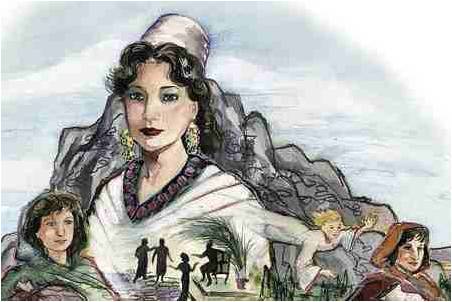By Jane Diffenderfer
The Book of Esther is not just the story of “once upon a time in a kingdom far way”, it is a living lesson for the saints of the Most High. According to Revelation 14:12, these saints are defined as those, “…that keep the commandments of God and the faith of Jesus [Yeshua].” Question, are the saints of the Book of Revelation two people groups, those that keep the commandments (Jews), and another who hold on to the faith of Yeshua (Christians)? Or, are they, one group of people, with one faith, who hold on to both the Torah/law and the testimony? The Book of Esther is a veiled prophecy, which reveals an answer to who the End Times people of God will be.
In the days of Queen Esther and Mordecai the Jew, the King of Persia had written decrees that were to be carried out in every province within his jurisdiction. These decrees were craftily written at the direction of the adversary Haman. These evil decrees were to murder all the Jews in territories of King Ahasuerus’s domain, including Jerusalem. They were written “…on the thirteenth day of the first month…according to all that Haman had commanded…in the name of King Ahasuerus”…the posts were sent into all the king’s provinces, with orders that in eleven month’s time, on a future date, the people of the kingdom were to destroy, kill, and cause to perish, “all Jews, both young and old, little children and women…The posts went out, being hastened by the king’s commandment, and the decree was given in Shushan the palace. And the king and Haman sat down to drink, but the city Shushan was perplexed” (Esther 3:12-14). How horrific!
The issuing of these dispatches muster their prophetic impact when they are layered upon the Biblical feasts, as commanded in the Torah (the first five books of Moses). What is the 13th day of the first month? According to Scripture, the first month is Nisan (or Aviv). What significance does this date have for Christians (those that have the testimony of Yeshua)? It is the day before Passover, the anniversary of the Last Supper, which was shared in the Upper Room. What do the Jews (those that keep the commandments) do on the 13th day of the first month? Prepare for Passover, the remembrance of the deliverance from Egypt.
During the reign of King Ahasuerus, the entire kingdom was confounded by the orders issued. But not Haman, the Agagite; he sat down to eat, drink, and be merry. Haman was of the seed of Amalek, the seed of Satan. He was following after his father the devil, with his murderous decrees and had no conscience about it. He must have been gloating that his orders were being sent out and distributed on the 14th of Nisan, just as Jewish parents were sitting down with their children to eat their Passover meal. What a total shock this news would be to the Jews, on the day set aside to celebrate their deliverance from Egypt! Not only were they being issued a death sentence, to be enacted eleven months later, their neighbors were forced, by the decree to commit the crime against them. No wonder everyone was perplexed in Shushan! Haman must have licked his chops at the idea that he had concocted such a scheme, to ruin the special feast of those he hated so passionately.
All seven of the abominations of the wicked one from Proverb 6 were emboldened in Haman. Haman was arrogant, who spoke lies against the Jews, and persuaded the king through his false witness, to give his royal stamp of approval to the evil imagination of his heart, the shedding of the innocent blood of Abraham’s seed. Haman acted swiftly in sending his dispatches throughout the provinces to sow discord in the kingdom. In one day, by one decree, neighbor was set against neighbor. The wicked lamp (1) illuminated in Haman had one agenda, death. Haman was not content with just one word, “kill” in his murderous decree. His agenda was to “kill, destroy, and annihilate” the Jewish people because “their laws are diverse from all people” (Esther 3:8). Haman despised the Torah and the people who kept the commandments of their God. The seed of Amalek hated the seed of Abraham with such blazing wrath, that Haman wanted to wipe the Torah honoring faithful from the face of the earth. This is a prophetic picture that continually repeats throughout time and history.
A fool says in his heart, there is no God. Haman was a fool, yet he thought he was wise. God in heaven cannot be mocked by men. He is a strong Deliverer and He will deliver His people, no matter what force of darkness comes against them. “Gather this into your soul: When all is said and done, Satan can’t win and you can’t lose… God always trumps Satan. Every hope and every victory the enemy thinks he has is maddeningly thwarted at the perfect time…His first giveaway should have been the timing.” (2)
The edict was written on the 13th day of Nisan and delivered on the 14th, just as the Jews in all the provinces were preparing to remember the Exodus from Egypt. This great deliverance celebration is an annual reminder of Yahweh’s ability to save His people through great signs and wonders. It is a night that parents are instructed to remind their children of God’s saving power by retelling the events of the destruction of Pharoah’s army. What a night to remember! With the news of Haman’s command, “what was meant to be a commemoration of a past event, suddenly turned into a concert of imminent need. Decades earlier, the Persian Jews had chosen not to take advantage of their deliverance under the decree of Cyrus, and their permission to return to Jerusalem. They decided they liked Persian life and stayed put. Then [along] came Haman. Maybe that’s one reason God allows ‘Hamans’ to come along in life – so we will quit being so at home here.” (3)
Those who had faith, during the dark hours of the death threat, could hope in the same God, Who delivered them from the bonds of Pharaoh, would also be able to deliver them from the hand of Haman. The saints are told to rehearse and remember the events of the Exodus. “And it shall come to pass when your children shall say unto you, ‘What mean ye by this service?’ That ye shall say, It is the sacrifice of the LORD’S [Yahweh’s] Passover, who passed over the houses of the children of Israel in Egypt when He smote the Egyptians and delivered our houses…” (Exodus 12:26-27). Remembering to observe the commandments of Passover, reminds us once again, of how great our God is!
For those who know Messiah Yeshua, Passover takes on an even deeper meaning of redemption. Yeshua, the Lamb of God, came to die to deliver His people from the bondage of sin. Passover is the annual memorial of our escape from the merciless control of the power of sin. The Passover seder has clues of eternal significance, “For as often as ye eat this bread [the unleavened bread of Passover], and drink this cup [the cup of redemption – the third cup of the Seder] ye do show the Lord’s death till He come” (1 Cor. 11:26).
When our Purim heroine, Queen Esther, learns of Haman’s evil decree, instead of feasting, she declares a fast. This fast lasts for three days and three nights. It begins on the first day of Unleavened Bread, Nisan 15th, and continues through the 16th and 17th of Nisan. What is the spiritual and prophetic impact these days have for Believers? These are the same days that Yeshua, was buried in the tomb!
End of Part 1 – Please read Part 2 of Purim and the Passover Deliverance, click on this link below:


I can definitely see themes through out Esther, in addition to the parallel to the 10 men hung on the gallows in Esther’s day lining up with the 10 Nazi war criminals hung on the gallows of 1946 on Purim…however I can’t seem to reconcile how Purim is in the week of Pesach. I’m pretty sure Purim this year is March 15th or so, but Passover is a full month out in April. If Purim was always on the 13th day of the first month and Passover is always on the 14th day of the first month then then there should be no difference from year to year…am I missing something?
Derek,
The original Purim drama happened in during the week of Passover and Unleavened Bread. We read in Esther 3:12 “Then were the king’s scribes called on the thirteenth day [day before Passover] of the first month [Aviv], and there was written according to all that Haman had commanded unto the king’s lieutenants…” The original issuance of decrees against the Jews of Persia fell on the eve of Unleavened Bread, in the days of Esther, Queen of Persia. Eleven months later, in the last month of the year, Adar, the Jews were victorious. Because of the victory, we celebrate the two days in the twelfth month, this year, Mar.15th and 16th.
Derek,
The original dramatic events of the life of Queen Esther’s exposing the dark deeds of Haman occurred in the first month of the year. The deliverance was celebrated 11 months later, during the last month on the calendar. That is why Purim occurs exactly one month earlier than Passover.
Thank you, Jane.
Just curious, should purim have been celebrate with Passover? I understand the months change from year to year but Passover is still on the 14th day
Deedee, the original drama, when Esther appeared before the King of Persia, took place during the first month of the Biblical new year. The deliverance was accomplished 11 months later, that is why Purim is celebrated one month before Passover.
You mean Rev. 14:12, not 12:14.
I hate to ask again because it looks like you’ve answered twice, but I’m still not getting it. I guess I’m a little slow. Anyway, the last paragraph says Esther’s fast coincides with the Feast of Unleavened Bread from 15-17 Nisan, but it doesn’t. Did the two actually coincide during this traumatic event in the book of Esther?
Ronnie, This is the timing of the events in Esther’s drama to save the Jewish people:
Esther 3:7-13 “In the first month, that is, the month Nisan, in the twelfth year of king Ahasuerus, they cast Pur, that is, the lot…Then were the king’s scribes called on the thirteenth day of the first month, and there was written according to all that Haman had commanded unto the king’s lieutenants, and to the governors that were over every province, and to the rulers of every people of every province according to the writing thereof, and to every people after their language; in the name of king Ahasuerus was it written, and sealed with the king’s ring. And the letters were sent by posts into all the king’s provinces, to destroy, to kill, and to cause to perish, all Jews, both young and old, little children and women, in one day, even upon the thirteenth day of the twelfth month, which is the month Adar…”
Esther’s dramatic fast, originally took place in the first month of the year (the month of Nisan, the month of Passover) and the final conclusion happened eleven months later during the month of Adar.
I finally got it! Lol! That is incredible! YHVH bless you. 🙂